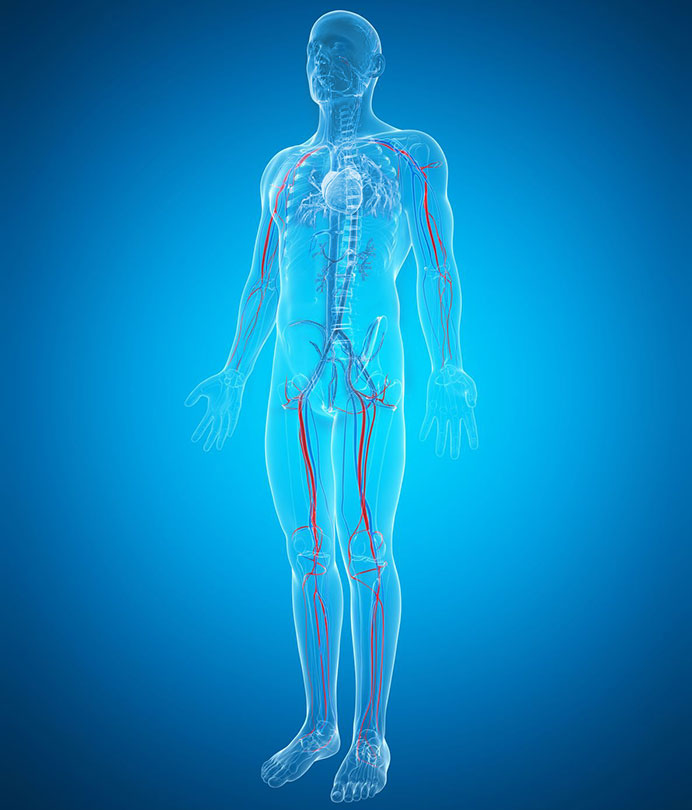Diagnostics
Upper / Lower Extremity Arterial
Diagnosing
Upper & Lower Extremity Arteries
The arteries of the upper and lower extremities function to transport oxygenated blood from the left side of the heart to the capillaries within the peripheral tissues. The arterial systems are designed to transport large volumes of blood at relatively high pressures (systolic pressures of 120mmHg). The named arteries systematically branch into smaller and smaller arteries until they reach the arterioles, where the pressure drops just before the blood enters the capillaries. Capilllaries connect the arterioles on one end and the venules on the other. As the blood traverses the capillaries, it delivers oxygen and nutrients and picks up carbon dioxide and toxic metabolic wastes that are returned to the right side of the heart via the venous system.
Arterial Disease
Peripheral arterial disease (PAD) is quite common, impacting approximately 10 million Americans. PAD is caused by atherosclerosis, or the gradual accumulation of calcified plaque in the arterial walls. Plaque can eventually restrict or completely block the flow of blood through the arteries. When the blockage or stenosis is tight enough, it can block blood flow to downstream organs such as the heart, brain, and extremities.
The biggest risk factors for developing atherosclerosis include elevated cholesterol and triglycerides, high blood pressure, smoking, chronic inflammation, and family history.
Arterial Ultrasound Examination
Duplex ultrasound examination of the arteries of the upper or lower extremities is performed to evaluate for arterial stenoses and blockages. Arterial duplex ultrasound uses real-time imaging and color Doppler to evaluate the structure and function of the named arteries in about 30 minutes. Because duplex technology allows evaluation of the blood flow as well as the arterial structure, it is considered the gold standard in evaluating the arterial system of the extremities. Because it does not use ionizing radiation, duplex ultrasonography is considered harmless and can be safely used with pregnant patients and patients of any age.There is no required prep and NPO is not necessary.

Indications
- Pain with ambulation (claudication)
- Rest pain
- Abdominal aortic aneurysm or stenosis
- Cold foot or leg
- Swelling
- Lower extremity cellulitis
- Brawny edema
- Non-healing foot ulcer
Common Findings
- Peripheral arterial disease (PAD)
- Arterial stenosis
- Arterial blockage
- Arterial aneurysm
- Baker’s cyst
CPT Codes
-
93925 – Duplex scan of lower extremity arteries, complete bilateral study
-
93926 – Duplex scan of lower extremity arteries, unilateral or limited study
-
93978 – Duplex scan of aorta, IVC, iliac vasculature, or bypass grafts, complete study
-
93979 – Duplex scan of aorta, IVC, iliac vasculature, or bypass grafts; unilateral or limited study
Common ICD-10 Codes
-
93925 – LOWER EXTREMITY ARTERIAL
-
M79.604 – Pain in right leg
-
M79.605 – Pain in left leg
-
I73.9 – Peripheral vascular disease, unspecified
-
I71.4 – Abdominal aortic aneurysm, without rupture
-
E11.59 – Type 2 diabetes mellitus with other circulatory complications
-
I70.211 – Atherosclerosis of native arteries of extremities with intermittent claudication, (R) leg
-
I70.212 – Atherosclerosis of native arteries of extremities with intermittent claudication, (L) leg
-
I70.213 – Atherosclerosis of native arteries of extremities with intermittent claudication, (B) legs
-
I73.00 – Raynaud’s syndrome without gangrene
-
I170.229 – Atherosclerosis of native arteries of extremities with rest pain, unspecified extremity
-
I70.25 – Atherosclerosis of native arteries of other extremities with ulceration
-
I70.90 – Unspecified atherosclerosis
-
I72.4 – Aneurysm of artery of lower extremity
-
I73.89 – Other specified peripheral vascular diseases
-
R94.30 – Abnormal result of cardiovascular function study, unspecified
-
I70.269 – Atherosclerosis of native arteries of extremities with gangrene, unspecified extremity
© 2022 Texas Sonography Associates | Site by JQ

